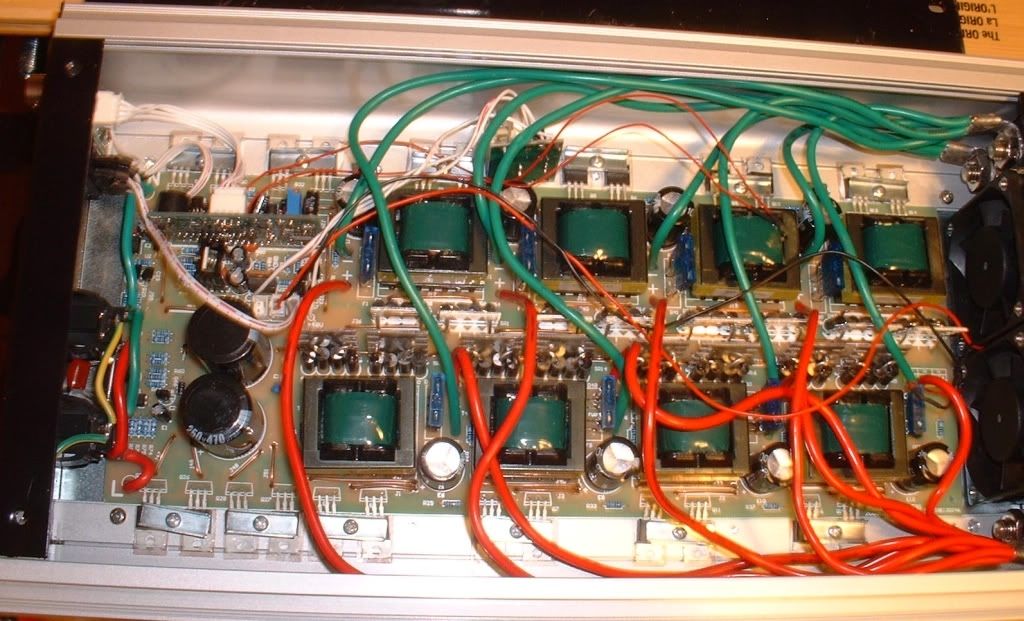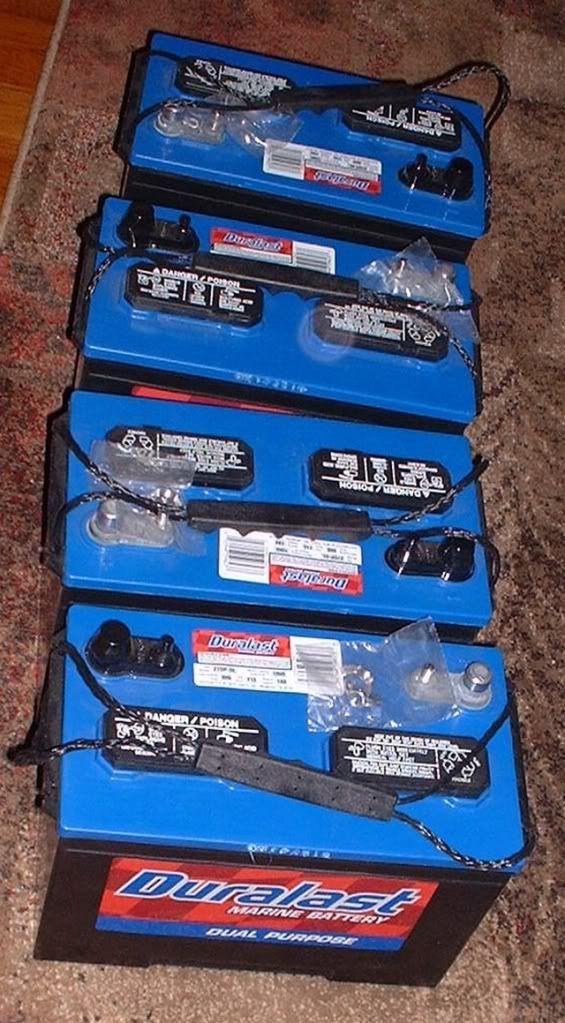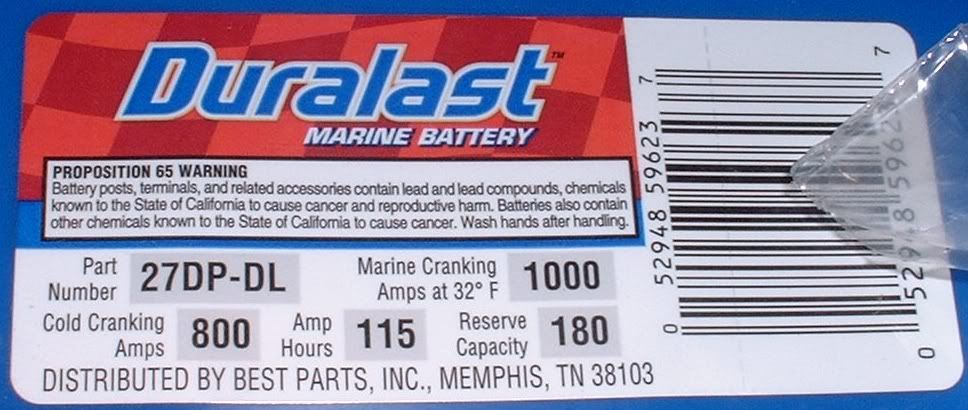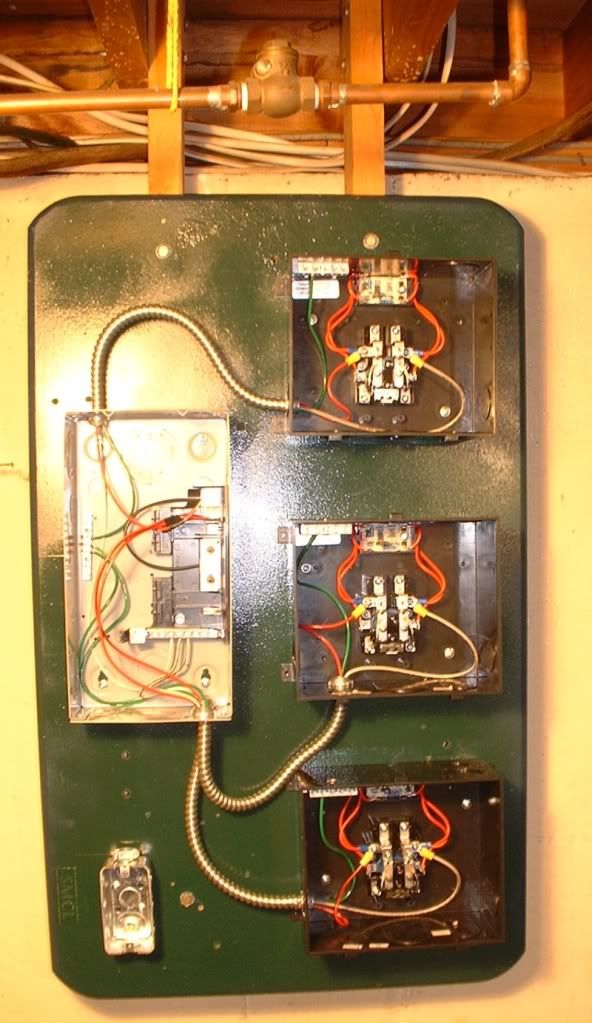
 |
|
|
#1 |
|
Lex Parsimoniae
Join Date: Feb 2009
Location: Woburn, MA
Posts: 4,918
Thanks: 114
Thanked 250 Times in 230 Posts
|
I tested the new inverter yesterday, after checking out the guts..
 Hooked it up to the 48V bank and ran it while charger was running. It came with some short cables.  In the evening, when there was no more solar, I decided to run the bank down a little bit, and test the inverter at the same time. I ran the inverter for about 6 hours, using incandescent bulbs as loads. Using 200 to 300 watts, while watching the bank voltage closely. Under load, (at 14:30) the bank started at off at 50.7 volts. (12.675 per battery). My target voltage was 49.5v, (12.375v per) which we hit at 20:30. I think that 12.375 is about 70 to 80% of a full charge. (See chart below). This morning started off real hazy and got better around 10AM. A little after lunch, the TS-45 charger & 500w of tracker PV had re-charged the bank to the tune of about 21.6 amp hours. This afternoon, I tested the inverter with a computer and CRT and they worked fine. At the end of the day, I checked the battery under load and it was 52.0v (13v per). I think this higher voltage is due to the temperature compensation function. Which increases the voltage slightly during the different charge modes. It's under 55 deg F in my basement.. I never saw the charge state go into 'Float' mode, but the charge current dropped from 7A (Bulk mode) in the morning, down to 2A at 13:00 (Absorption mode). But, So far, I'm pleased with performance of the charger and PV. I might have to adjust the temperature compensation off-set, after I take some more under-load voltage readings tonight. This chart shows how different loads affect the voltage during discharge. I was using around 4 amps.  |
|
|

|
|
|
#2 |
|
Lex Parsimoniae
Join Date: Feb 2009
Location: Woburn, MA
Posts: 4,918
Thanks: 114
Thanked 250 Times in 230 Posts
|
Power source is 500w of tracking PV array
 Charge controller is a TS-45 (PWM)  Bank is 48v of Marine batteries from AutoZone   Inverter is 2.5kW MSW. (48v DC input 120VAC out).  Wholesale 2500W/5000W POWER INVERTER STACKABLE DC 12V TO AC 110V |
|
|

|
|
|
#3 |
|
Lex Parsimoniae
Join Date: Feb 2009
Location: Woburn, MA
Posts: 4,918
Thanks: 114
Thanked 250 Times in 230 Posts
|
 I plan to do my layout kinda like this, but I'll keep the inverter over near the battery bank, since it needs very fat wires (high amperage). That way, I can install a small Aux breaker box and use the breakers as the inverter AC cut-offs, and also control which (of 3) household AC branches are going to be fed by the Inverter. MSW voltage isn't suitable for some loads..  |
|
|

|
|
|
#4 |
|
Administrator
Join Date: Aug 2008
Location: Germantown, WI
Posts: 5,525
Thanks: 1,162
Thanked 374 Times in 305 Posts
|
Woo, looking good so far.

__________________
Current project - To view links or images in signatures your post count must be 0 or greater. You currently have 0 posts. To view links or images in signatures your post count must be 0 or greater. You currently have 0 posts. & To view links or images in signatures your post count must be 0 or greater. You currently have 0 posts. |
|
|

|
|
|
#5 |
|
Lex Parsimoniae
Join Date: Feb 2009
Location: Woburn, MA
Posts: 4,918
Thanks: 114
Thanked 250 Times in 230 Posts
|
While the PV was charging the battery bank this morning, I turned on the MSW inverter, and tested it on a few things in the basement.
1. 1/3 HP Ace sump pump (short test, no water) 2. Large Craftsman power drill (360w) 3. Ceramic space heat (at 952w) 4. Small basement freezer (180w intermittently for 3 hours) I had a 100watt flood lamp plugged in while I was running these tests, and didn't see any dimming at all. The solar charge controller did it's work earlier this morning and has been in 'Float' mode. All the juice for the testing is extra PV power that wasn't being used.. (So, I didn't waste any power)..  It looks like the inverter uses very little power in standby mode. (Without loads). I think it's less than 5W. Will have to use a real amp meter to tell for sure. Last edited by Xringer; 01-03-11 at 12:38 PM.. Reason: standby |
|
|

|
|
|
#6 |
|
Lex Parsimoniae
Join Date: Feb 2009
Location: Woburn, MA
Posts: 4,918
Thanks: 114
Thanked 250 Times in 230 Posts
|
One of the main goals of this back-up system is to provide 2 to 3 hours of power for four sump pumps.
Since the 4 pumps (each using about 300 watts) would start up and run at random times, with about 30 seconds to 1 minute of run time, per 3 to 5 minutes of Off time. It's very likely that normal flooding will cause the use of less power, than would be used by running 400 watts continuously. My guesstimate is 0.3 to 1.0 kWh being used during each hour of flooding, depending on the height of the flood-water table. (Unless we get another 100 year flood, ahead of schedule).  The main load is these three new pumps and one old Ace Hardware 1/3 HP pump.   The Gray box is a SumpJet water powered sump pump. (In case everything else fails)..  The run time of the battery bank during a flood will depend on SOC and if the sun comes out. Most of our flooding occurs 1 to 3 days after heavy rain has stopped. So, there is a possibility that battery life could be greatly extended by the PV. Which, at 300 to 500 watts could drive the pumps while simultaneously recharging the bank. ~~ The reason for the 2 to 3 hours of power as my goal is simple. In 90% of power failures during flooding, the power is quickly restored. In any kind of weather, 90% of the time, NStar has restored power in less than 3 hours. Two or three hours of a dead grid, should be plenty of time to roll the 5KW gas generator out of the garage and get it running. (Which is something that I would like to avoid if possible). But it might be unavoidable if the flooding is heavy and the battery bank falling low too fast.. Cheers, Rich |
|
|

|
|
|
#7 |
|
Lex Parsimoniae
Join Date: Feb 2009
Location: Woburn, MA
Posts: 4,918
Thanks: 114
Thanked 250 Times in 230 Posts
|
Yesterday I worked on the layout for my board..
 (That little blue box on the lower left is just a place holder for metal boxes). Today fiberboard is up and ready for the boxes.. |
|
|

|
|
|
#8 |
|
Lex Parsimoniae
Join Date: Feb 2009
Location: Woburn, MA
Posts: 4,918
Thanks: 114
Thanked 250 Times in 230 Posts
|
 I've wired the ground and the two hot lines into the 3 switchers. The inverter will feed in to the breakers (left box), which will drive the relays. When the inverter comes on, it will disconnect my loads from the grid and feed them with juice from the inverter. |
|
|

|
|
|
#9 |
|
Guest
Posts: n/a
|
Wow. That looks really great. But it does really look complicated too. How much did you spend to all of that? Is it less complicated to build than we see it? Hehe
|

|
|
|
#10 | |
|
Lex Parsimoniae
Join Date: Feb 2009
Location: Woburn, MA
Posts: 4,918
Thanks: 114
Thanked 250 Times in 230 Posts
|
Quote:
A much simpler rig would be a GTI (Grid tied Inverter), which just connects the PV (panels) to the grid. It's a little more complicated than being off-the-grid, since it has switches to allow a few house circuits to go off the grid when needed. (At least when I finish wiring it up).  I didn't track the price paid for parts, since I never expect to see any kind of break-even or pay-back that many people look for as the goal of getting to Alternate power sources. I'm not looking for a hand-out from the government, since the goal of this project is Back-up power. Like the gas generator in the garage. I do try to get good deals.. My panels were all about $300 each. The CS6P-200 panels are still being sold on Ebay at a good price if you can get them to accept your offer. I'll try to draw a good diagram of the system. I'll post it here. Cheers, Rich Last edited by Xringer; 01-14-11 at 08:32 AM.. Reason: clearness |
|
|
|

|
 |
|
|